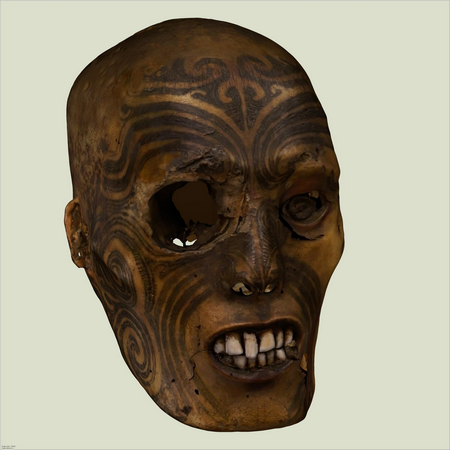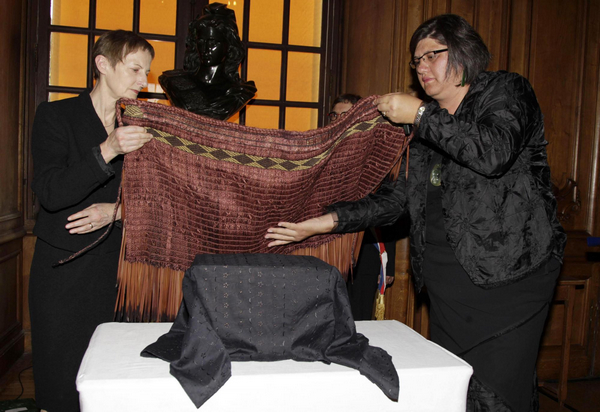Society
Maori head returns to New Zealand after 136 years
Updated: 2011-05-09 22:23
(Agencies)
|
 A three-dimensional view of a Maori head, realized during the head's modelling, is seen in this handout given by Rouen Museum on May 9, 2011. France returns the mystic relic in a ceremony at Rouen city hall more than a century after explorers took it from New Zealand.[Photo/Agencies]
|
ROUEN, France -- A French museum has returned the mummified and tattooed head of a Maori to New Zealand officials after spending 136 years in a Normandy museum, a belated gesture to restore dignity to the first of 16 such human heads once displayed as exotic curiosities.
Representatives of New Zealand's native Maori people sang traditional songs during an elaborate ceremony at Rouen City Hall to hand over the head to New Zealand diplomats, the first to be returned from of a total of 16 in France.
"It's truly a solemn and symbolic day," New Zealand ambassador Rosmary Banks said. "We are very happy at the return" of the tattooed head after so many years in Rouen, Banks said.
For years, New Zealand has sought the return of Maori heads kept in collections abroad, many of which were obtained by Westerners in exchange for weapons and other goods.
Dozens of museums worldwide, though not all, have agreed to return them. Maori, the island nation's indigenous people, believe their ancestors' remains should be respected in their home area without being disturbed.
Michelle Hippolite, a Maori spiritual leader and co-director of the museum in Wellington that will take possession of the head, welcomed the return. She said that the other 15, now at museum all around France, will be returned in 2012.
Hippolite said that "though it may appear" that Rouen's museum is losing part of its collection, it is gaining "an ongoing relationship with a modern people, a people of its time who are tenacious, a people of its time who are courageous."
|
 New Zealand's Ambassador Rosemary Banks (L) and Maori spiritual leader Michelle Hippolite cover a box containing a Maori head with a Korowai during a ceremony held at Rouen city hall in western France May 9, 2011.[Photo/Agencies] |
The Rouen Museum tried once before, in 2007, to return the head but was stopped at the last minute by the Culture Ministry of France. France considers human remains conserved in museums to be part of its cultural or scientific heritage. A law was passed last year allowing the return of the heads.
French Sen. Catherine Morin-Desailly authored the bill to return the heads. Scientists at Wellington's Te Papa museum will attempt to identify the head's tribe, after which it will be returned to the tribe for burial.
Some Maori heads, with intricate tattoos, were traditionally kept as trophies from tribal warfare. But once Westerners began offering prized goods in exchange for them, men were in danger of being killed simply for their tattoos, French museum officials have said.
Little is known about how the Rouen Museum acquired a Maori head in 1875, offered by a Parisian named Drouet.
"It's an enigma," said museum director Sebastien Minchin, adding that neither Drouet's full name nor profession is known.
The head has not been displayed since 1996, when the museum was closed for a decade. Prior to that the head was displayed with the prehistoric collection.
"As was done at the time, they compared the 'savage' from the other side of the world with our local cavemen," Minchin said in a telephone interview.
It isn't known whether the Rouen museum's head belonged to a warrior or a slave.
The head will be first taken to London where New Zealand officials are collecting other Maori heads that have been returned from collections in Germany, Sweden and Norway, before being flown to New Zealand, where they will be handed over during a ceremony at the Te Papa museum on Thursday.
So far the Te Papa museum has repatriated more than 180 ancestral remains from 12 countries. Museum officials estimate that there are still more than 500 around the world.
When Minchin became director in 2006 and discovered the head, he decided to store it because exposing it "could pose problems" for both the Maoris and the public.
Minchin said that the problem goes beyond legal issues in France. He said he was criticized for opening "Pandora's box" when he first tried to return the head.
"There is a fear of emptying our museums," he said. "There is a fear of restitution demands for other human remains, and notably Egyptian mummies."
France passed a special law before the 2002 return to South Africa of the skeleton and bottled organs of Saartjie Baartman, a 19th century African woman exhibited in Paris and London, sometimes in a cage, sometimes dressed in feathers, under the pejorative nickname, "the Hottentot Venus."
Specials

2011 Sino-US Dialogue
China and the United States will hold the third round of the Strategic and Economic Dialogue from May 9-10 in Washington.

Bin Laden dead
The world's most wanted man was killed in a US raid in Pakistan.

US-style sports camp
The US sports camp company, Camp Woodward, will open its first residential camp in Beijing in June.